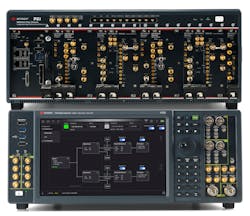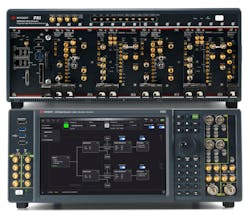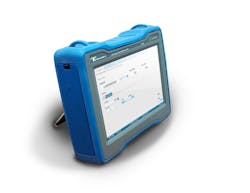Instruments offer multiple formfactors, functions
While responding to requests for input for last month’s report on signal generators,1 instrument makers also commented on the tradeoffs involved in various formfactors and multiple-instrument functionality. Although they were commenting in the context of signal generators, their observations on instrument formfactors apply to other instrument classes as well.
Different types, different advantages Signal generators come in a variety of configurations, such as traditional benchtop instruments, handheld instruments with display, USB instruments, and PXI modules. What do vendors see as the advantages and disadvantages of each?
Brandon Malatest, founder and CEO of Per Vices Corp.: The different configurations available each meet unique needs for different applications. Traditional benchtop instruments are still the most common and offer engineers the best overall solution when comparing performance, cost, and usability. These systems are the best option for R&D use where access to high-performance equipment is needed. The drawbacks for these systems are typically a combination of portability, size, and power consumption, depending on the configuration.
Steve Sandler, founder and CEO of Picotest: Tradeoffs are made in each configuration, with the PXI typically being highest performance and USB maybe the lowest performance. The bigger question is about user demand, which is looking to see a single GUI interface and preferably an all-in-one instrument. You can see evidence of this primarily from the oscilloscope manufacturers, which all now include frequency-response-analyzer functionality using built-in signal generators. Many scopes include two channels of signal generators.
Oliver Rovini, technical director of SPECTRUM Instrumentation GmbH: We see three different main classes here. First, benchtop instruments with a display and full manual control are best for everyday work at the lab with changing and individual demand. Second, modular instruments based on a common bus system like PCIe or PXI are the best fit for integrated devices or OEM products. They can be used for easy integration into user programs and offer a very high streaming speed that allows [the user] to replay large signals or do modifications on-the-fly as needed in simulation. Third, [we see] external instruments that are operated by a PC via Ethernet or USB. As nearly all benchtop instruments also have one or even both interfaces, there is some overlapping here. The external instruments can be used as a replacement for modular instruments without the need of a large PCI or PXI housing and could even be operated by a laptop.
Simon Ache, director of signal generation product management at Rohde & Schwarz: The number of use cases for signal generators are manifold, and so are the sizes and configurations. Small, self-contained, modular, and faceless signal generators can be operated via USB or LAN, offering space and performance advantages in remote-controlled applications. At the same time, they avoid incompatibilities that might occur when using PXI-based signal generation cards of vendor A together with modules of vendor B in a PXI chassis of vendor C. Handheld generators are good for field use, but battery up-time is often low. Benchtop instruments are available in the most diverse sizes and performance classes. Modern benchtop instruments are equipped with touchscreen interfaces that are as easy to use as one’s mobile phone. These instruments are perfect for R&D lab use but can also be flexibly remote-automated for production usage so that this traditional approach still offers the most flexible usage.
Jon Semancik, director of marketing at Marvin Test Solutions: Interfaces such as USB and LXI are typically used in rackmount box solutions, which do not have the size restrictions found in card-based solutions. This simplifies the task of component placement and shielding but also increases the overall footprint of the solution. PXI certainly reduces the size of the solution, but the added space and size restrictions place demands on the designer to carefully consider component placement and shielding to maximize the performance of the instrument.
James McGregor, global head of test, tools, and production supplies at Newark: First, handheld instruments with display—While portability is the clear advantage, handheld instruments with displays generally suffer from lower performance due to constraints on size and weight as lots of functionality is being squeezed into a single instrument. Second, USB instruments provide great portability but again, performance is restricted, and a PC is required to work with the equipment, reducing flexibility. Third, PXI modules are great for mass-production testing, and users are able to customize with other modules in a single test solution; nevertheless, they do require a PXI rack to work with other PXI modules. Fourth, traditional benchtop instruments can provide all levels of performance depending on your needs but can be bulky and space can be limited on your bench if you choose all equipment in single desktop formats. The choice for users investing in equipment broadly falls between size and flexibility vs. performance—and very much depends on the type of testing that the user will need to undertake.
Chris Armstrong, director of product marketing and SW applications, RIGOL Technologies: While each configuration has its place, RIGOL focuses on benchtop instruments that are easy to control via USB or Ethernet. This provides the flexibility of stand-alone operation and direct computer control in a platform that does not incur overhead costs for the engineer.
Steve Fairbanks, senior director, marketing, products, and instrumentation at Astronics Test Systems: The worth of each configuration is ultimately determined by the deployment environment or use case. Having the flexibility, as a supplier, to provide similar capabilities in a wide variety of form factors gives us a better chance to address our customers’ challenges, specifically for their application.
Mark Elo, U.S. sales manager for Tabor Electronics: [An optimal] form factor allows an instrument to perform the best job it can in the environment it is deployed in, whether it’s R&D, production, maintenance, or somewhere else. Our philosophy is to have a signal-generator platform that we can deploy in multiple form factors—this provides consistency across our customers’ product lifecycles.
Multifunction The trend toward multifunctionality has resulted in modern instruments that incorporate a signal generator, oscilloscope, DMM, and more all in one solution. What are the main benefits of such a multifunction instrument?
Sandler, Picotest: As previously mentioned, there is definitely a one-box desire. I’m not certain, but I think it comes down to usability. A single GUI interface to learn would seem to be the heart of the desire, with next maybe being bench crowding. The response to expensive solutions is good, so I don’t believe it is about money. What you lose is the performance in some cases. For example, the spectrum and signal-source analysis on an oscilloscope will never come close to that of a signal source analyzer, but a multifunction instrument might well accomplish the 90%.
Malatest, Per Vices: These multifunctional systems offer greater flexibility without the tradeoff of performance, which was evident in the past. The new systems can utilize the flexibility and performance of SDRs, which offer all of the performance benefits of traditional systems with the bonus of flexibility, smaller physical footprint, and lower cost when compared to purchasing different equipment for each purpose.
Rovini, SPECTRUM Instrumentation: While multifunction devices may be a cost benefit with a trade-off in signal quality and functionality, SPECTRUM's approach here is the modular concept that allows the combination of multiple cards of different functions internally with a synchronization concept called Star-Hub. This allows users to individually set-up systems combining a various number of AWG and digitizer channels and even extend this over the years when the need is increasing.
Ache, Rohde & Schwarz: Actually, this trend is not new. Radio-communication testers are well-established products that incorporate signal-generator and signal-analyzer functionality in one. Especially in high-volume production, it is common to have such a combined instrument, which offers benefits regarding floor space and test procedures. However, in scenarios where compact, standalone instruments such as traditional signal generators are being remotely controlled, the benefits of a one-box multifunction instrument often are diminished. This is especially true for high-end applications and R&D at the edge of what is technologically feasible.
Semancik, Marvin Test Solutions: The clear advantage of this approach is a reduced system footprint. However, as with many all-in-one solutions, the overall performance and specified accuracies of the individual functional blocks may be reduced. While this may not be an issue for some applications, it is important for the user to evaluate the performance of each area prior to adopting this type of solution.
Cassacia, Lee, Zhang, and Hsu, Keysight Technologies: The key benefits for a multifunction instrument are precise timing synchronization, a small footprint, and low cost of test. For example, Keysight X-Series signal generators provide several built-in instruments: a function generator for enabling or controlling devices under test, a bit error rate (BER) tester for receiver sensitivity test, a power meter for flatness correction and general power measurement, a digital signal processor (DSP) for real-time signal processing, additive white gaussian noise, and real-time fading. For customized and advanced test systems, PXI and AXIe modular platforms address the engineers’ demand for greater measurement speed, including data transfers and synchronization across instrument modules.
McGregor, Newark: First, a multifunction piece of equipment is more portable, and less connection is needed during setup. Second, users only need to calibrate a single instrument for their test solution. Third, overall cost to purchase and maintain the test solution is much cheaper than with individual pieces of equipment.
Armstrong, RIGOL Technologies: Multifunctional instruments can save space, reduce cost, and increase usability. Care must be taken to make sure each instrument function is still intuitive. Newer instruments, like touchscreen oscilloscopes, make a great platform for many instrument functions. For performance and noise characteristics RIGOL keeps high-performance RF signal generators in a separate instrument. This maximizes function and capability.
REFERENCE
1. “Generating Value,” EE-Evaluation Engineering, Nov. 2019, p. 6.
2. One Size Does NOT Fit All: Choosing the Right Instrument Form Factor, Application Note, Keysight Technologies, Dec. 1, 2017.
About the Author

Rick Nelson
Contributing Editor
Rick is currently Contributing Technical Editor. He was Executive Editor for EE in 2011-2018. Previously he served on several publications, including EDN and Vision Systems Design, and has received awards for signed editorials from the American Society of Business Publication Editors. He began as a design engineer at General Electric and Litton Industries and earned a BSEE degree from Penn State.



